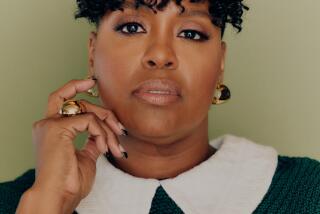Movie Reviews : A Good Idea Gets Done to ‘Death’
- Share via
“Death Becomes Her” is a black comedy that is so pleased with its blackness it frequently forgets to be funny. An elaborate piece of work with more than a little on its nasty mind, “Death” finally falls flatter than many a less ambitious film, proof once again that just because an idea is audacious doesn’t necessarily mean it’s good.
Written by Martin Donovan & David Koepp (who collaborated on the equally odd and unsatisfying “Apartment Zero”), “Death’s” frenetic and flabbergasting script is certainly different and, as such, attracted some powerful admirers. Stars Meryl Streep, Goldie Hawn and Bruce Willis all signed on, as did director Bob Zemeckis (“Back to the Future,” “Romancing the Stone”), which was enough to get Universal to spring for the estimated $35 million the project cost.
With its Dorian Grayish emphasis on the extremes people will go to remain young and beautiful, “Death’s” story of two rivals who consider no price too great to pay to halt the aging process, including, just for openers, falling for the same colorless plastic surgeon (Willis’ role, believe it or not), is clearly more thought-provoking than watching an oversized 2-year-old tromp around Las Vegas.
And, in its pair of wacky extended prologues that play out before the main action begins, the film is nervy enough to create anticipation about where things are headed. Which makes it all the more surprising and disappointing when that destination turns out to be nowhere much at all.
“Death Becomes Her” (citywide, rated PG-13) opens at a Broadway opening, circa 1978. The play is “Songbird!,” a heaven-help-us musical version of Tennessee Williams’ “Sweet Bird of Youth,” and the star is the game but aging fast ingenue Madeline Ashton (Streep). The audience is understandably aghast, with two noticeable exceptions. Helen Sharp (Hawn), an old rival of Madeline’s, would clearly like to leave, but she is with her fiance, Ernest Menville (Willis), a tweedy, balding wimp who can’t keep his eyes off the stage.
And when a backstage visit reveals that this is the Ernest Menville, plastic surgeon extraordinaire, the wrinkle-phobic Madeline sets out to add him to the considerable list of men she’s stolen from Helen. Which leads to the second prologue, set seven years later, in which a seriously obese Helen (courtesy of a wickedly effective fat suit created by Lance and David Anderson out of something called flabbercast) is in the process of eating herself into oblivion before a sudden resolution turns her life around.
These early parts of “Death,” acted with a kind of cold-blooded verve, promise amusement later on, and when the film switches forward yet another seven years (to 1992, if you’ve lost count) and we find the L.A.-based Madeline still obsessed with her looks and poor Menville reduced to a job not quite as upscale as his previous work, we hope for the best.
It is at this point, however, with Helen about to reappear on the scene, that an increasingly hysterical Madeline takes the step that will change both her life and the movie. On a dark and stormy night (oblivious to the local drought, this film is filled with nothing but dark and stormy nights) she makes a visit to the sinister castle of Lisle von Rhumans (Isabella Rossellini), supplier of the glistening potion that is so prominently displayed in the film’s ad campaign.
What that liquid specifically does to and for her, and to her relationship to both Helen and Menville, ought to be seen rather than described. In general it provides the opportunity for extensive use of computer-generated shape-shifting special effects of the type that made “Terminator 2” so memorable.
Created, as were the “T2” visuals, by Industrial Light & Magic, these effects are quite something. Unfortunately, like a bad traffic accident, they stop “Death Becomes Us” dead in its tracks. For the filmmakers were apparently so taken with this new toy they didn’t realize that it is no substitute for funny plotting and clever lines, neither of which this film displays much of from here on in.
Instead, “Death” gets progressively darker and darker, forgetting all about humor in its attempts to push the more mordant limits of its story. The three principals are game enough about all this, soldiering on until the end, but their characters, not having much to do that they haven’t done before, tend to sound the same single notes they have since Frame One.
There is something regrettable in all this, because by industry standards this picture does take a few risks, and few enough pictures in today’s Hollywood take any at all. But even though “Death Becomes Her” has no fear of being out on the edge, brazenness alone is no guarantee of success.
‘Death Becomes Her’
Meryl Streep: Madeline Ashton
Bruce Willis: Ernest Menville
Goldie Hawn: Helen Sharp
Isabella Rossellini: Lisle von Rhumans
Released by Universal Pictures. Director Robert Zemeckis. Producers Robert Zemeckis and Steve Starkey. Co-producer Joan Bradshaw. Screenplay Martin Donovan & David Koepp. Cinematographer Dean Cundey. Editor Arthur Schmidt. Costumes Joanna Johnston. Music Alan Silvestri. Production design Rick Carter. Art director Jim Teegarden. Set decorator Jackie Carr. Running time: 1 hour, 43 minutes.
MPAA-rated PG-13.
More to Read
Only good movies
Get the Indie Focus newsletter, Mark Olsen's weekly guide to the world of cinema.
You may occasionally receive promotional content from the Los Angeles Times.











